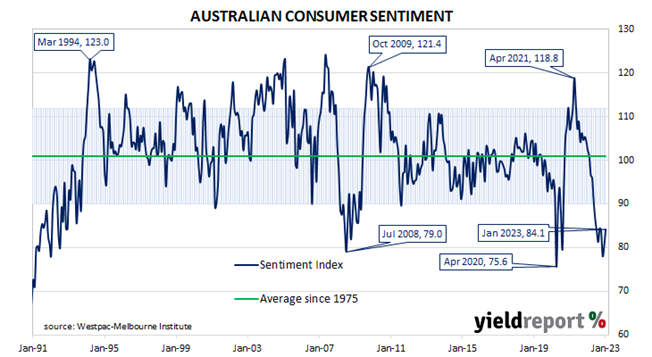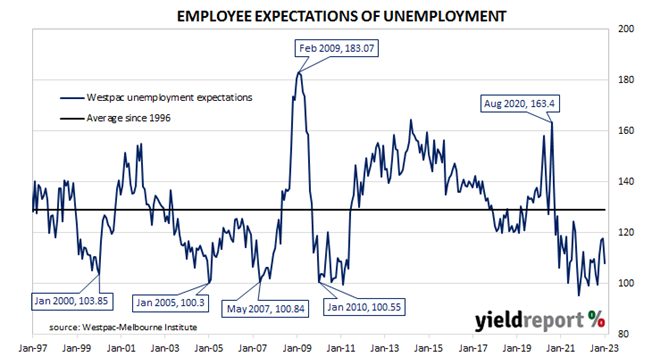Summary: Household sentiment improves in January; readings comparable with depths of early 1990s recession, “still depressingly low”; no RBA rate increase “likely explanation” for result; all sub-indices higher; fewer respondents expecting higher jobless rate.
After a lengthy divergence between measures of consumer sentiment and business confidence in Australia which began in 2014, confidence readings of the two sectors converged again in mid-July 2018. Both measures then deteriorated gradually in trend terms, with consumer confidence leading the way. Household sentiment fell off a cliff in April 2020 but, after a few months of to-ing and fro-ing, it then staged a full recovery. However, consumer sentiment has deteriorated significantly over the past year, while business sentiment has been more robust.
According to the latest Westpac-Melbourne Institute survey conducted in the second week of January, household sentiment has improved again. Their Consumer Sentiment Index rose from December’s reading of 80.3 to 84.1, a reading which is still well below the “normal” range and significantly lower than the long-term average reading of just over 101.
“Sentiment is still depressingly low. The January read is in the bottom 10% of observations since the mid-1970s,” said Westpac Chief Economist Bill Evans. “We have to go all the way back to the depths of the deep recession in the early 1990s to find a period where Index reads were consistently below those seen over the last six months, including the improved print in January.”
Any reading of the Consumer Sentiment Index below 100 indicates the number of consumers who are pessimistic is greater than the number of consumers who are optimistic.
Commonwealth Government bond yields slipped a little at the short end on the day while long-term yields moved modestly higher. By the close of business, the 3-year ACGB yield had lost 1bp to 3.23%, the 10-year yield had inched up 1bp to 3.62% while the 20-year yield finished 2bps higher at 3.99%.
In the cash futures market, expectations regarding future rate rises remained essentially unchanged. At the end of the day, contracts implied the cash rate would rise from the current rate of 3.07% to average 3.215% in February and then increase to an average of 3.555% in May. August 2023 contracts implied a 3.735% average cash, as did November 2023 contracts.
Evans put forward a “likely explanation” for the improvement in consumer confidence, noting no change to the Bank’s cash rate target in January. “While that was because there was no RBA Board meeting in the month rather than an explicit decision by the Bank to leave rates unchanged, the break in the tightening cycle looks to have provided some relief.”
All five sub-indices registered higher readings, with the “Economic conditions – next 12 months” sub-index posting the largest monthly percentage gain.
The Unemployment Expectations index, formerly a useful guide to RBA rate changes, fell from 117.9 to 108.0. Lower readings result from fewer respondents expecting a higher unemployment rate in the year ahead.



